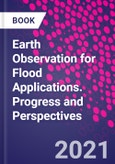Earth Observation for Flood Applications: Progress and Perspectives describes the latest scientific advances in Earth Observation. With recent floods around the world becoming ever more devastating, there is a need for better science enabling more effective solutions at a fast pace. This book aims at stretching from the current flood mapping to diverse real data so as to estimate the flood risk and damage. Earth Observation for Flood Applications: Progress and Perspectives includes three parts containing each a separate but complementary topic area under floods. Each chapter unfolds various applications, case studies, and illustrative graphics. In terms of flood mapping and monitoring, the usage of multi-sensor satellite data, web-services information, microwave remote sensing methods are discussed in depth. So, this book is a valuable resource for scientists, researchers, and students in the area of earth observation.
Please Note: This is an On Demand product, delivery may take up to 11 working days after payment has been received.
Table of Contents
Section 1. Monitoring and Modeling Flood Processes and Hazards1. Earth Observation for Flood Applications: Progress and Perspectives
2. An Automatic System for Near-Real Time Flood Extent and Duration Mapping Based on Multi-Sensor Satellite Data?
3. Flood Mapping with Passive Microwave Remote Sensing: Current Capabilities and Directions for Future Development
4. River Flood Modeling and Remote Sensing Across Scales: Lessons from Brazil
5. Using the Surface Water and Ocean Topography Mission Data to Estimate River Bathymetry and Channel Roughness
Section 2. Estimating Flood Exposure, Damage and Risk
6. From Cloud to Refugee Camp: A Satellite-Based Flood Analytics Case-Study in Congo-Brazzaville
7. DFO-Flood Observatory
8. How Earth Observation Informs the Activities of the Re/Insurance Industry on Managing Flood Risk
9. Flood Detection and Monitoring with EO Data Tools and Systems
Section 3. Emerging Applications and Challenges
10. Emerging Remote Sensing Technologies for Flood Applications
11. Earth Observations for Anticipatory Action: Case Studies in Hydrometeorological Hazards
12. Earth Observation and Hydraulic Data Assimilation for Improved Flood Inundation Forecasting
13. Artificial Intelligence for Flood Observation
14. The Full Potential of EO for Flood Applications: Managing Expectations
15. Emerging Techniques in Machine Learning for Processing Satellite Images of Floods
16. Merged AMSR-E/AMSR-2 and GPM Passive Microwave Radiometry for Measuring River Floods, Runoff, and Ice Cover
Authors
Guy J-P. Schumann University of Bristol (UK), Remote Sensing Solutions, Inc. (USA). Dr. Guy Schumann is the founder and a principal scientist at RSS-Hydro. Dr. Schumann isalso a Research Fellow at Geographical Sciences, University of Bristol and an affiliate at the
Dartmouth Flood Observatory (DFO), INSTAAR at the University of Colorado Boulder, CO. He
received both the MSc (Remote Sensing) and PhD (Geography) degrees from the University
of Dundee (United Kingdom) in 2005 and 2008, respectively. Dr. Schumann has more than
15 years of experience in the field of remote sensing data integration with hydrodynamic
modeling and particularly radar remote sensing and its use in flood models. Dr. Schumann has
over 150 publications, including papers, book chapters, and edited books. Most of his current
work and projects focusing on simulating river hydrodynamics and floodplain inundation
and integration with remote sensing. Dr. Schumann is also involved in the Interoperability
Program activities of the Open Geospatial Consortium (OGC)








